实验八 进程间通信
Posted 不要脸红
tags:
篇首语:本文由小常识网(cha138.com)小编为大家整理,主要介绍了实验八 进程间通信相关的知识,希望对你有一定的参考价值。
| 项目 | 内容 |
|---|---|
| 这个作业属于哪个课程 | Linux系统与应用 |
| 这个作业的要求在哪里 | 实验八作业要求 |
| 学号-姓名 | 18041525-石霖 |
| 作业学习目标 | 了解进程间通信的常用方式; 掌握管道、消息队列、信号量、共享内存实现进程间通信的方法。 |
1.举例说明使用匿名管道进行进程通信。
匿名管道
当进程使用 pipe 函数,就可以打开位于内核中的这个特殊“文件”。同时 pipe 函数会返回两个描述符,一个用于读,一个用于写。
如果你使用 fstat 函数来测试该描述符,可以发现此文件类型为 FIFO 。而无名管道的无名,指的就是这个虚幻的“文件”,它没有名字。
man 2 pipe
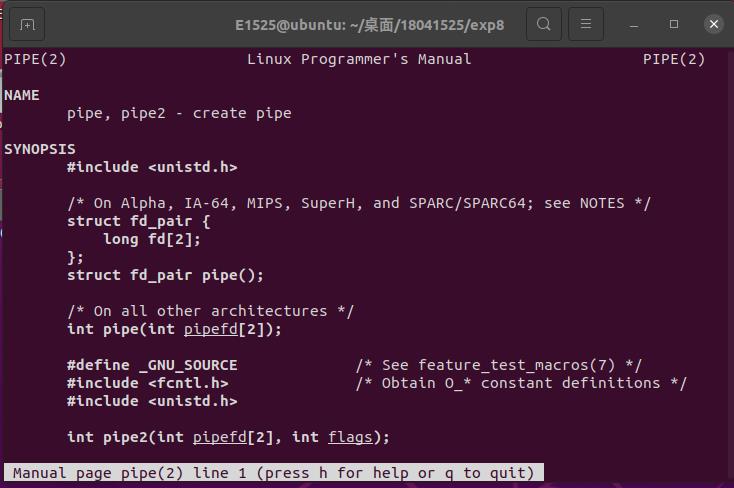
pipe 函数打开的文件描述符是通过参数(数组)传递出来的,而返回值表示打开成功(0)或失败 (-1)。
它的参数是一个大小为 2 的数组。此数组的第 0 个元素用来接收以读的方式打开的描述符,而第 1 个元素用来接收以写的方式打开的描述符。
也就是说, pipefd[0] 是用于读的,而 pipefd[1] 是用于写的。
打开了文件描述符后,就可以使用 read(pipefd[0]) 和 write(pipefd[1]) 来读写数据了。


如果关闭读 ( close(pipefd[0]) ) 端保留写端,继续向写端 ( pipefd[1] ) 端写数据( write 函数)的进程会收到 SIGPIPE 信号。
如果关闭写 ( close(pipefd[1]) ) 端保留读端,继续向读端 ( pipefd[0] ) 端读数据( read 函数),read 函数会返回 0.
例题:父进程 fork 出一个子进程,通过无名管道向子进程发送字符,子进程收到数据后将字符串中的小写字符转换成大写并输出。
//hellopipe.c
#include <stdio.h>
#include <unistd.h>
#include <stdlib.h>
#include <ctype.h>
void child(int *fd) {
close(fd[1]); // 子进程关闭写端
char buf[64];
int n = 0,i;
while(1) {
n = read(fd[0], buf, 64);//如果没有数据可读,read会阻塞;如果父进程退出,read返回0.
for (i = 0; i < n; ++i)
putchar(toupper(buf[i]));
if (*buf == \'q\') {
close(fd[0]);
exit(0);
}
if (n == 0) {
puts("no data to read!");
sleep(1);
}
}
exit(0);
}
int main() {
int fd[2];//作为传出参数
int n = 0;
char buf[64] = { 0 };
if (pipe(fd) < 0) {
perror("pipe");
return -1;
}
pid_t pid = fork();
if (pid == 0) {
child(fd);
}
close(fd[0]);// 父进程关闭读端
while (1) {
n = read(STDIN_FILENO, buf, 64);
write(fd[1], buf, n);
if (*buf == \'q\') {
close(fd[1]);
exit(0);
}
}
return 0;
}
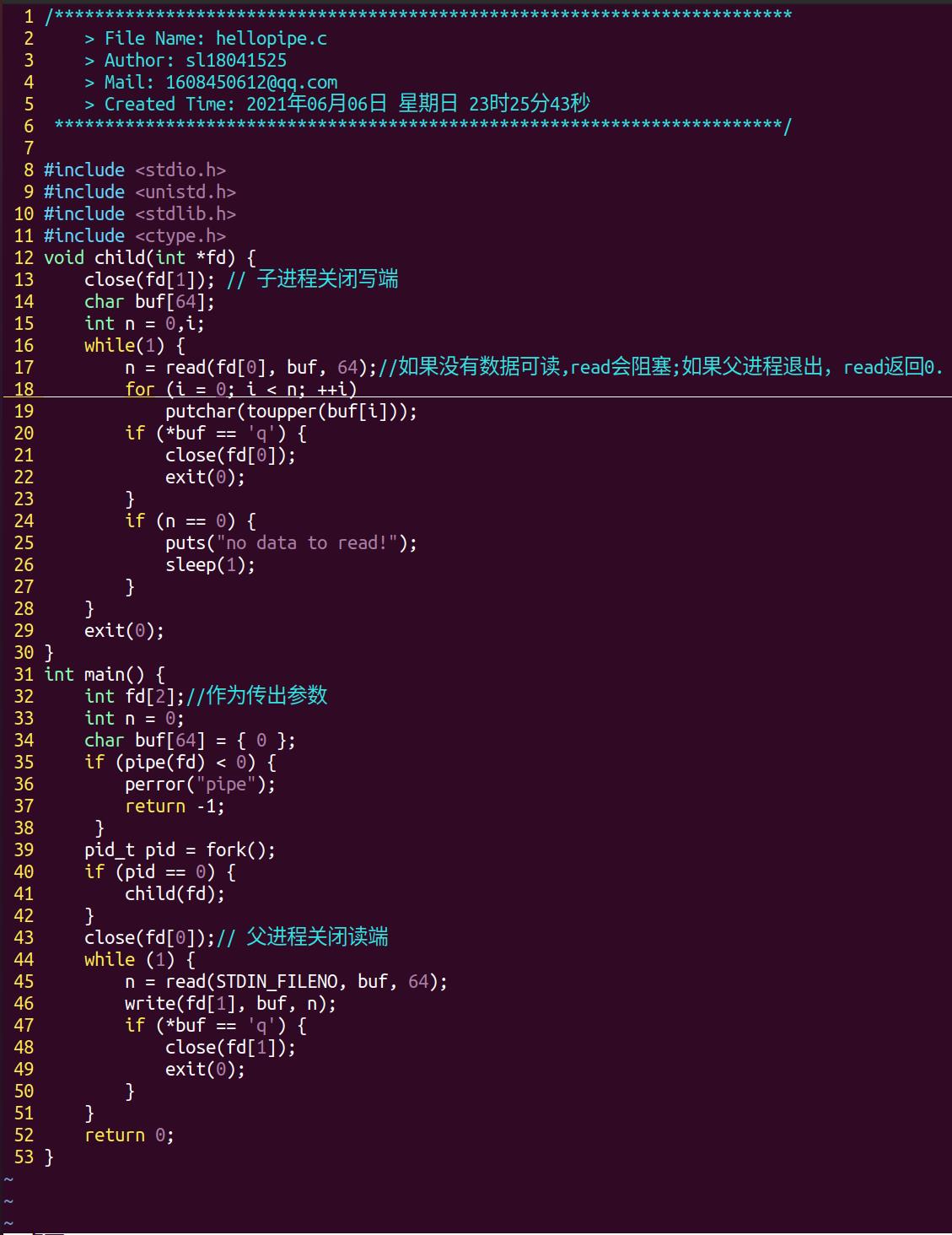
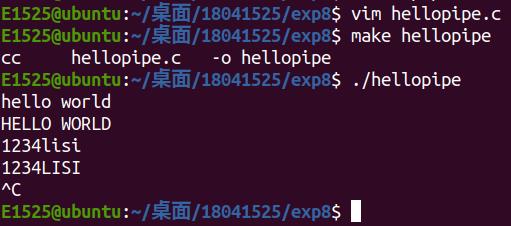
2.举例说明使用 mkfifo 命令创建命名管道以及简单演示管道如何工作。
命名管道
1.通过命令 mkfifo 创建管道
man mkfifo
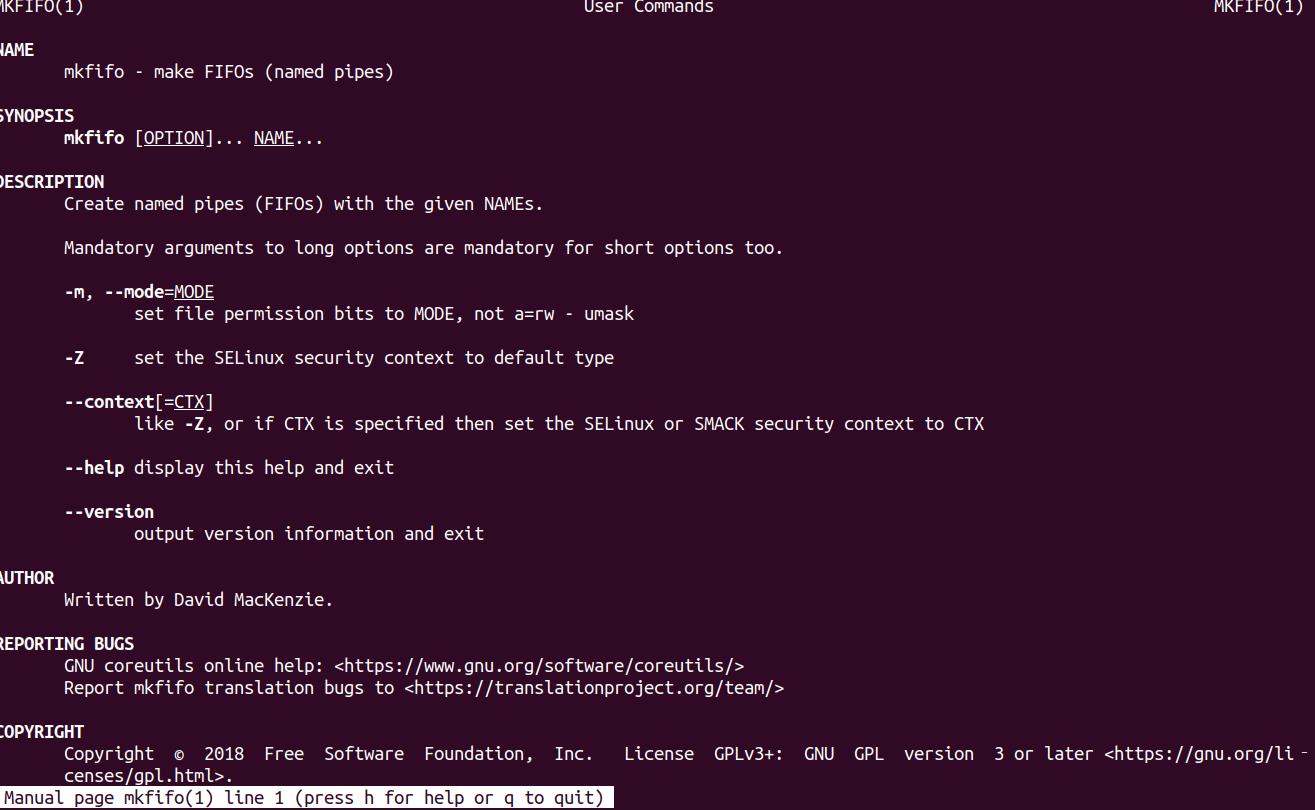
2.通过函数 mkfifo(3) 创建管道
man 3 mkfifo

FIFO文件的特性
a) 查看文件属性
当使用 mkfifo 创建 hello 文件后,查看文件信息如下:

某些版本的系统在 hello 文件后面还会跟着个 | 符号,像这样 hello|
b) 使用 cat 命令打印 hello 文件内容

可以看到cat已经被堵塞了。
开启另一个终端,执行

然后你会看到被阻塞的 cat 又继续执行完毕,在屏幕打印 “hello world” 。
如果你反过来执行上面两个命令,会发现先执行的那个总是被阻塞。

c) fifo 文件特性
根据前面两个实验,可以总结:
(1)文件属性前面标注的文件类型是 p ,代表管道
(2)文件大小是 0
(3)fifo 文件需要有读写两端,否则在打开 fifo 文件时会阻塞
如果在 open 的时候,使用了非阻塞方式,肯定是不会阻塞的。
特别地,如果以非阻塞写的方式 open ,同时没有进程为该文件以读的方式打开,会导致 open 返回错误(-1),同时 errno 设置成ENXIO.
3.编写两个程序使用第2题中创建的管道进行通信
例题:编写两个程序,分别是发送端 pipe_send 和接收端面 pipe_recv 。程序 pipe_send 从标准输入接收字符,并发送到程序 pipe_recv ,同时 pipe_recv 将接收到的字符打印到屏幕
// pipe_send.c
#include <unistd.h>
#include <sys/types.h>
#include <sys/stat.h>
#include <fcntl.h>
#include <stdio.h>
int main() {
char buf[64];
int n = 0;
int fd = open("hello", O_WRONLY);
if (fd < 0) {
perror("open fifo");
return -1;
}
puts("has opend fifo");
while((n = read(STDIN_FILENO, buf, 64)) > 0) {
write(fd, buf, n);
if (buf[0] == \'q\')
break;
}
close(fd);
return 0;
}
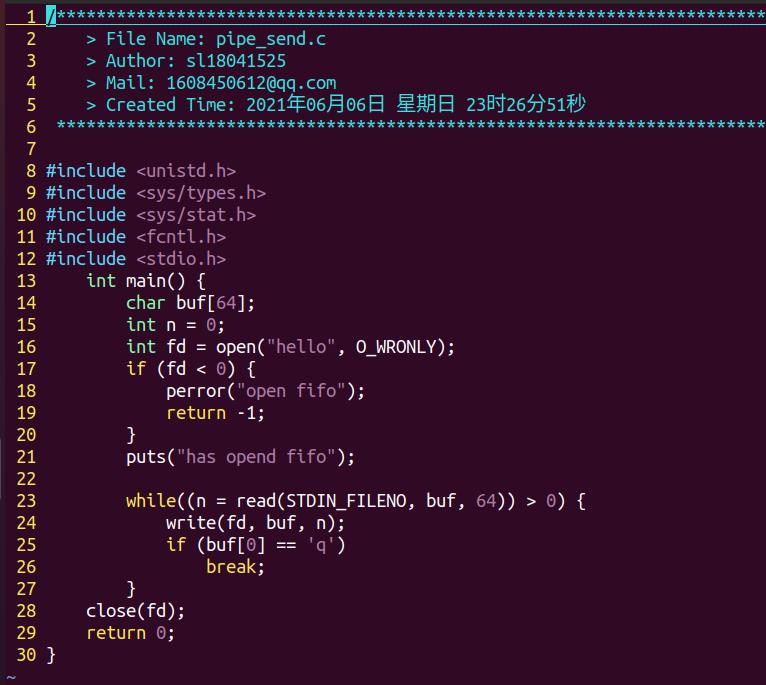
// pipe_recv.c
#include <unistd.h>
#include <sys/types.h>
#include <sys/stat.h>
#include <fcntl.h>
#include <stdio.h>
int main() {
char buf[64];
int n = 0;
int fd = open("hello", O_RDONLY);
if (fd < 0) {
perror("open fifo");
return -1;
}
puts("has opened fifo");
while((n = read(fd, buf, 64)) > 0) {
write(STDOUT_FILENO, buf, n);
}
if (n == 0) {
puts("remote closed");
}
else {
perror("read fifo");
return -1;
}
close(fd);
return 0;
}

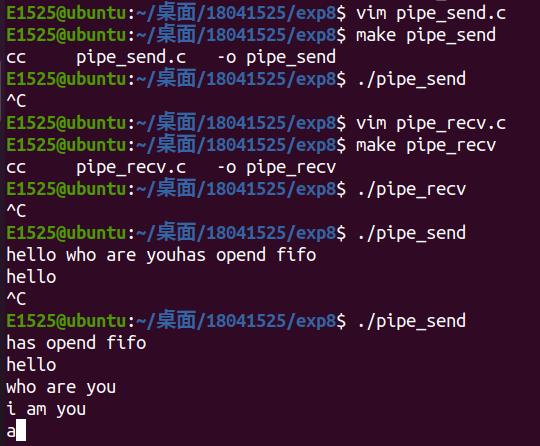
现在两个终端都处于阻塞状态,在运行pipe_send的终端输入数据,然后就可以在运行的pipe_recv的终端看到相应的输出:

使用组合按键结束上述进程。
4.编写两个程序分别通过指定的键值创建 IPC 内核对象,以及获取该指定键值的 IPC 内核对象。
IPC 内核对象
每个 IPC 内核对象都是位于内核空间中的一个结构体。具体的对于共享内存、消息队列和信号量,他们在内核空间中都有对应的结构体来描述。
当你使用 get 后缀创建内核对象时,内核中就会为它开辟一块内存保存它。只要你不显式删除该内核对象,它就永远位于内核空间中,除非你关机重启。
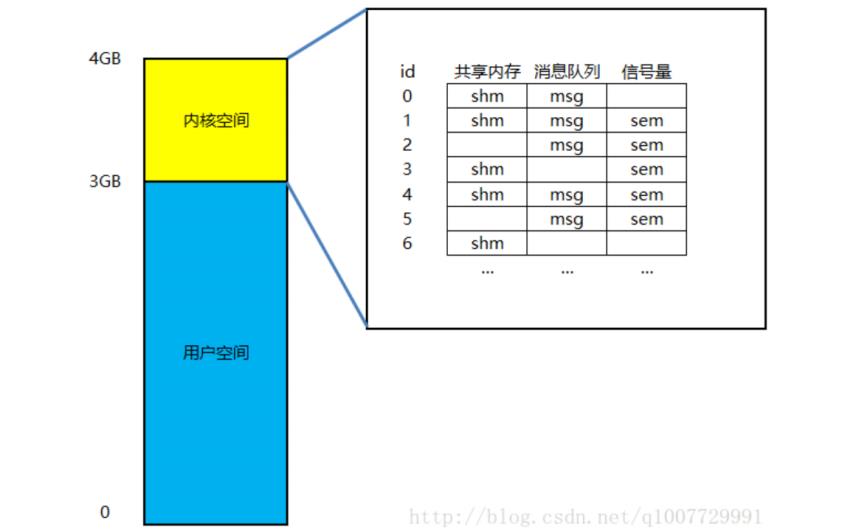
进程空间的高 1G 空间( 3GB-4GB )是内核空间,该空间中保存了所有的 IPC 内核对象。
上图给出不同的 IPC 内核对象在内存中的布局(以数组的方式),实际操作系统的实现并不一定是数组,也可能是链表或者其它数据结构等等。
每个内核对象都有自己的 id 号(数组的索引)。此 id 号可以被用户空间使用。所以只要用户空间知道了内核对象的 id 号,就可以操控内核对象了。
为了能够得到内核对象的 id 号,用户程序需要提供键值—— key ,它的类型是 key_t ( int 整型)。
系统调用函数( shmget , msgget 和 semget )根据 key ,就可以查找到你需要的内核 id号。
在内核创建完成后,就已经有一个唯一的 key 值和它绑定起来了,也就是说 key 和内核对象是一 一对应的关系。(key = 0为特殊的键,它不能用来查找内核对象)
创建 IPC 内核对象
man 2 shmget
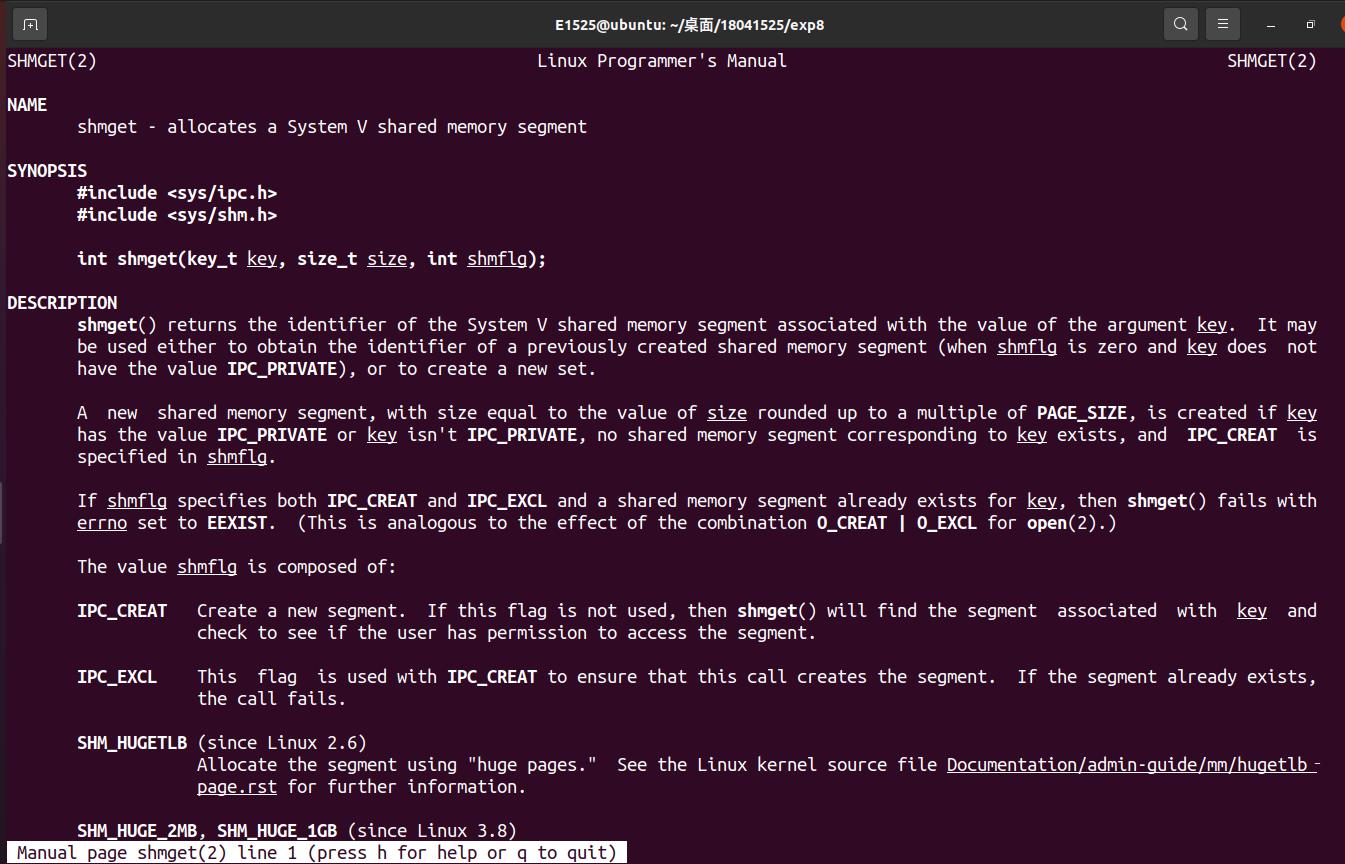
man 2 msgget
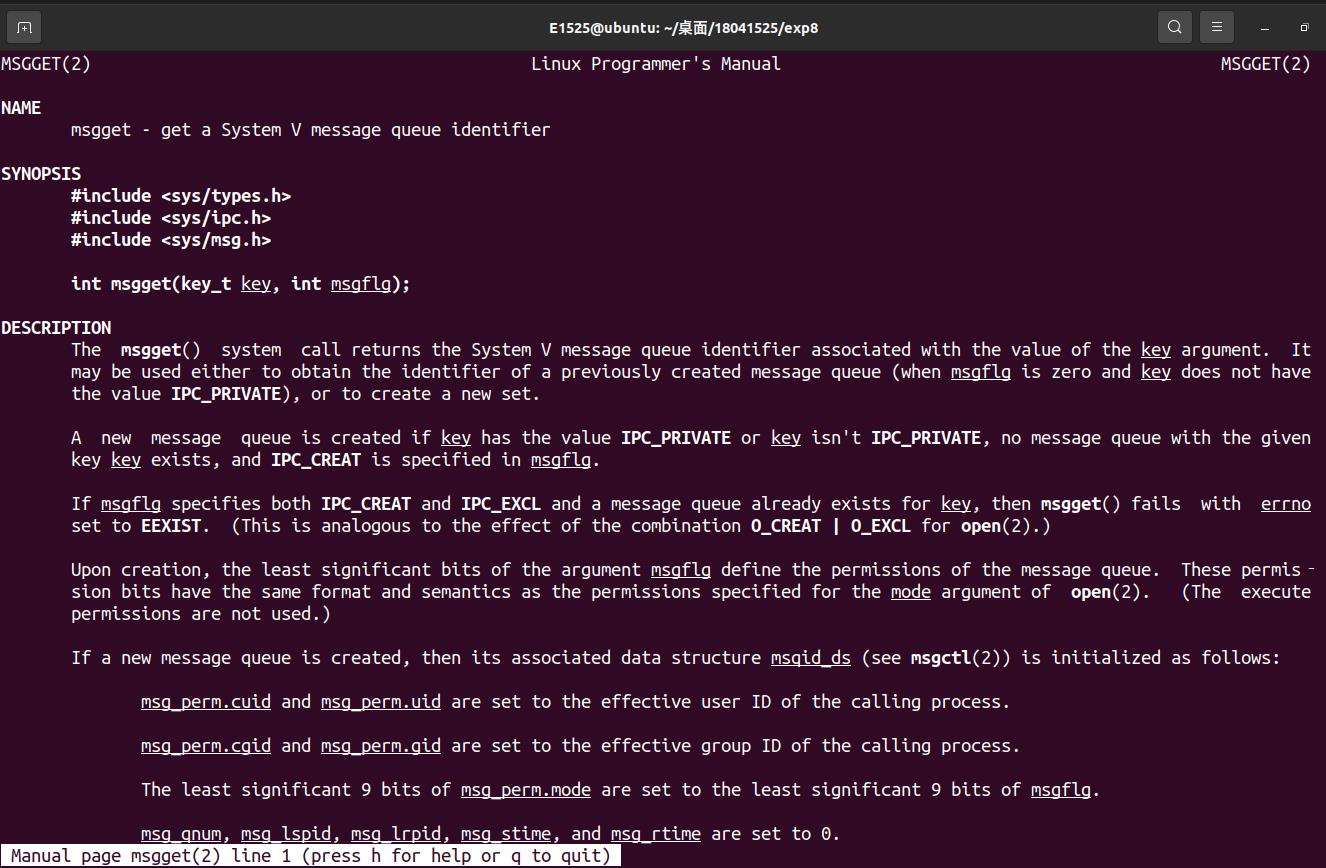
man 2 semget
在创建 IPC 内核对象时,用户程序一定需要提供 key 值才行。
实际上,创建 IPC 内核对象的函数和获取内核对象 id 的函数是一样的,都是使用 get 后缀函数。
比如在键值 0x8888 上创建 ipc 内核对象, 并获取其 id ,应该像下面这样:
// 在 0x8888 这个键上创建内核对象,权限为 0644,如果已经存在就返回错误。int id = shmget(0x8888, 4096, IPC_CREAT | IPC_EXCL | 0644);int id = msgget(0x8888, IPC_CREAT | IPC_EXCL | 0644); int id = semget(0x8888, 1, IPC_CREAT | IPC_EXCL | 0644); // 第二个参数表示创建几个信号量
例题:程序 ipccreate 用于在指定的键值上创建 ipc 内核对象。使用格式为 ./ipccreate ,比如./ipccreate 0 0x8888 表示在键值 0x8888 上创建共享内存。
//ipccreate.c #include <unistd.h> #include <sys/ipc.h>#include <sys/shm.h> #include <sys/msg.h>#include <sys/sem.h> #include <stdio.h> #include <stdlib.h> #include <string.h> int main(int argc, char* argv[]) { if (argc < 3) { printf("%s <ipc type> <key>\\n", argv[0]); return -1; } key_t key = strtoll(argv[2], NULL, 16);//key char type = argv[1][0];// char buf[64]; int id; if (type == \'0\') {//创建共享内存 id = shmget(key, getpagesize(), IPC_CREAT | IPC_EXCL | 0644); strcpy(buf, "share memory"); } else if (type == \'1\') {//创建消息队列 id = msgget(key, IPC_CREAT | IPC_EXCL | 0644); strcpy(buf, "message queue"); } else if (type == \'2\') {//创建信号量 id = semget(key, 5, IPC_CREAT | IPC_EXCL | 0644); strcpy(buf, "semaphore"); } else { printf("type must be 0, 1, or 2\\n"); return -1; } if (id < 0) { perror("get error"); return -1; } printf("create %s at 0x%x, id = %d\\n", buf, key, id); return 0; }
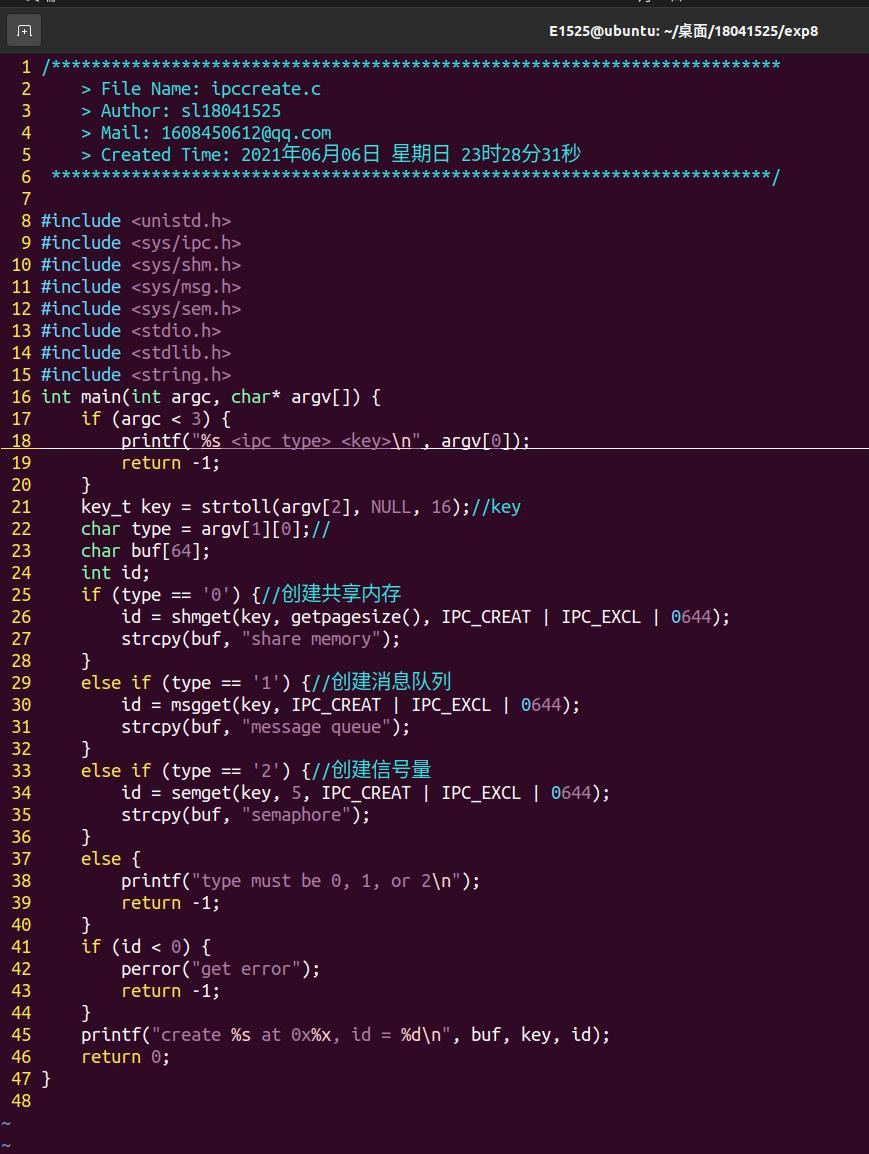
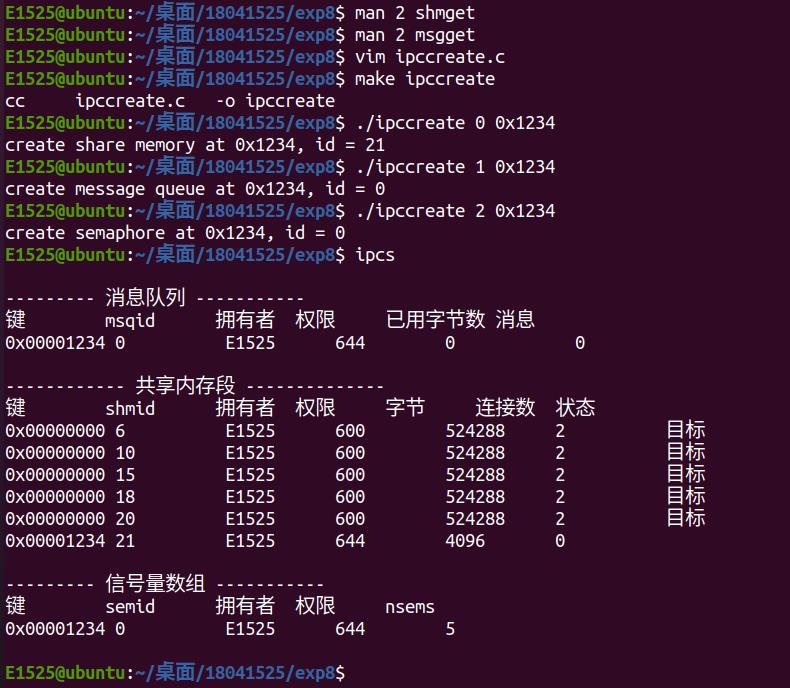
获取ipc内核对象
程序 ipcget 用于在指定的键值上获取 ipc 内核对象的 id 号。
使用格式为 ./ipcget ,比如./ipcget 0 0x8888 表示获取键值 0x8888 上的共享内存 id 号。
//ipcget.c #include <unistd.h> #include <sys/ipc.h> #include <sys/shm.h> #include <sys/msg.h> #include <sys/sem.h> #include <stdio.h>#include <stdlib.h> #include <string.h> int main(int argc, char* argv[]) { if (argc < 3) { printf("%s <ipc type> <key>\\n", argv[0]); return -1; } key_t key = strtoll(argv[2], NULL, 16); char type = argv[1][0]; char buf[64]; int id; if (type == \'0\') { id = shmget(key, 0, 0); strcpy(buf, "share memory"); } else if (type == \'1\') { id = msgget(key, 0); strcpy(buf, "message queue"); } else if (type == \'2\') { id = semget(key, 0, 0); strcpy(buf, "semaphore"); } else { printf("type must be 0, 1, or 2\\n"); return -1; } if (id < 0) { perror("get error"); return -1; } printf("get %s at 0x%x, id = %d\\n", buf, key, id); return 0; }
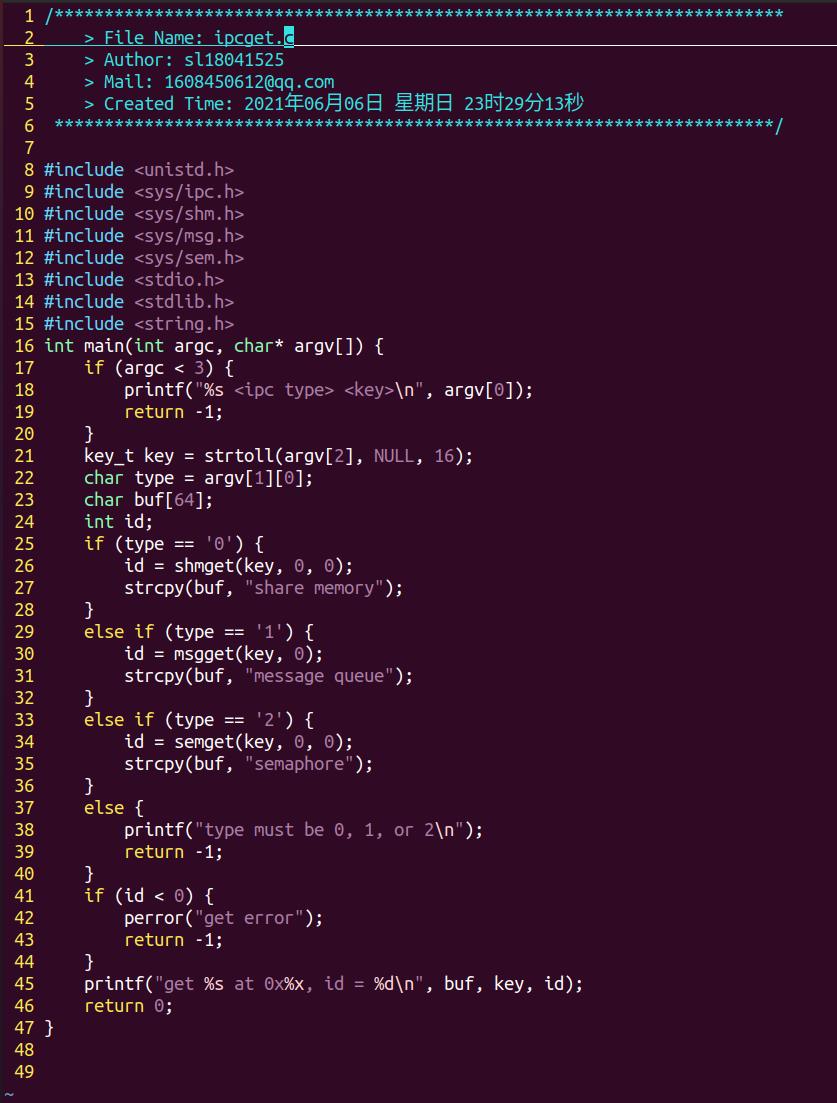
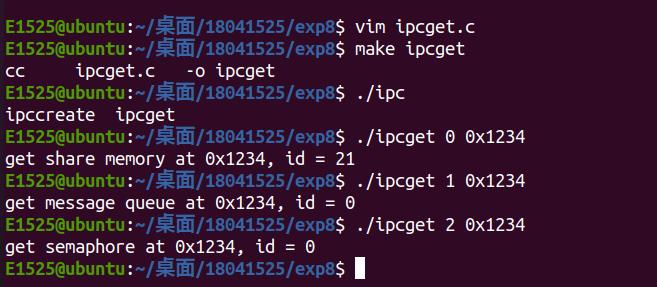
5.编写一个程序可以用来创建、删除内核对象,也可以挂接、卸载共享内存,还可以打印、设置内核对象信息。
共享内存
前面已经知道如何创建内核对象,接下来分别了解三种内核对象的操作:
man 2 shmop
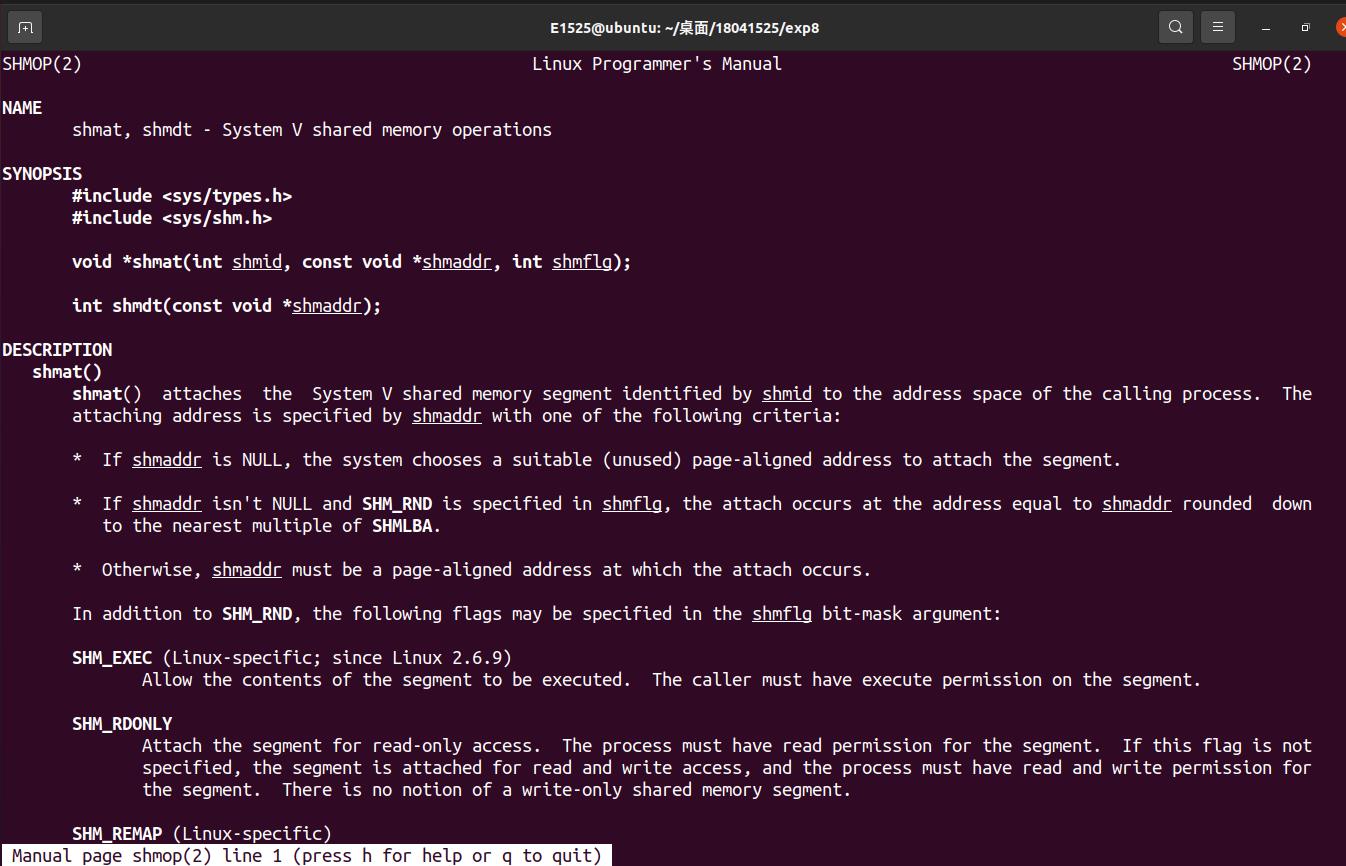
man 2 shmctl
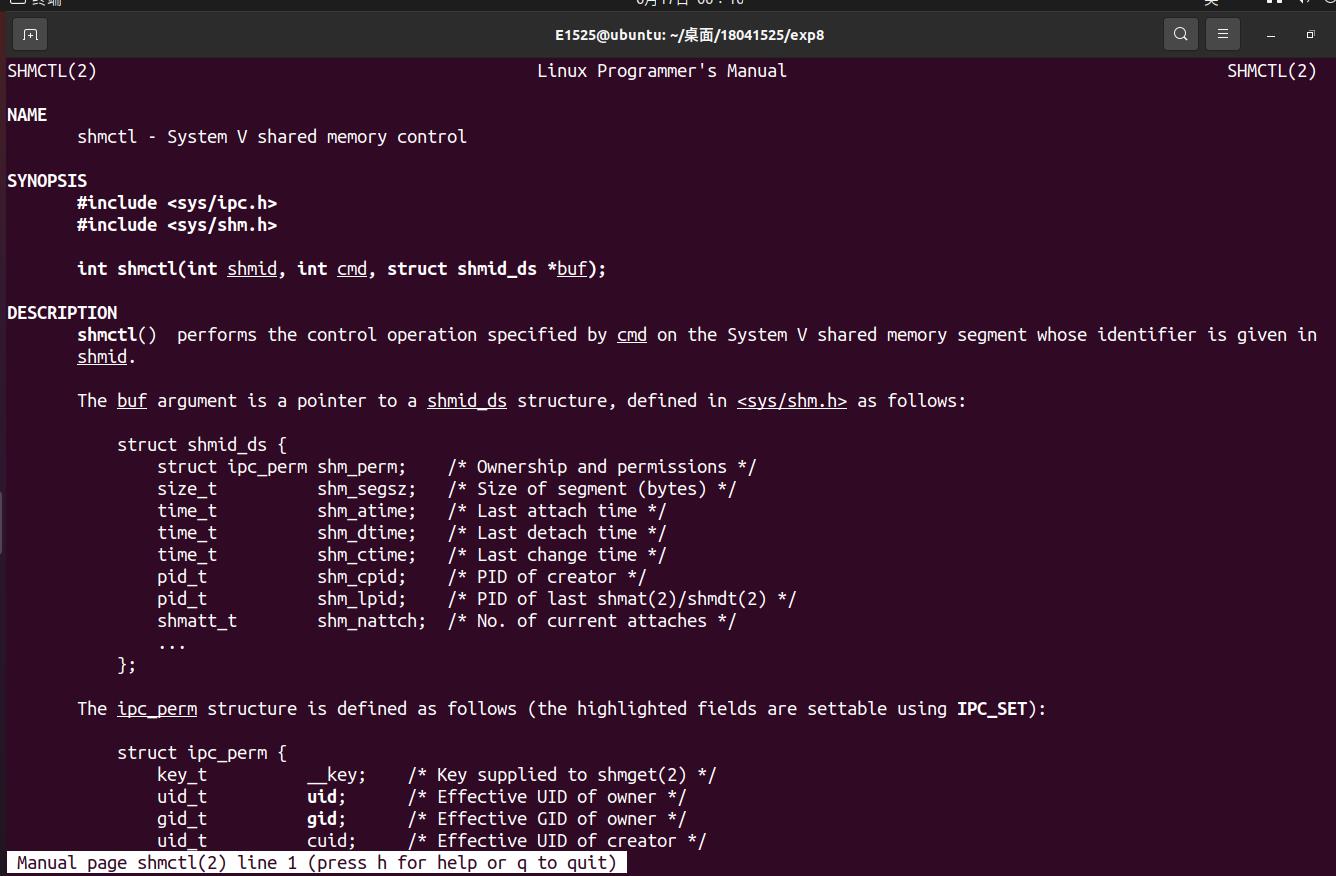
例题:编写一个程序 shmctl 可以用来创建、删除内核对象,也可以挂接、卸载共享内存,还可以打印、设置内核对象信息。具体使用方法具体见下面的说明:
./shmctl -c : 创建内核对象。./shmctl -d : 删除内核对象。./shmctl -v : 显示内核对象信息。./shmctl -s : 设置内核对象(将权限设置为 0600 )。./shmctl -a : 挂接和卸载共享内存(挂接 5 秒后,再执行 shmdt ,然后退出)。//shmctl.c #include <unistd.h> #include <sys/ipc.h> #include <sys/shm.h> #include <stdio.h> #include <time.h>#include <stdlib.h>#include <string.h>#define ASSERT(res) if((res)<0){perror(__FUNCTION__);exit(-1);} // 打印 ipc_perm void printPerm(struct ipc_perm *perm) { printf("euid of owner = %d\\n", perm->uid); printf("egid of owner = %d\\n", perm->gid); printf("euid of creator = %d\\n", perm->cuid); printf("egid of creator = %d\\n", perm->cgid); printf("mode = 0%o\\n", perm->mode);}// 打印 ipc 内核对象信息void printShmid(struct shmid_ds *shmid) { printPerm(&shmid->shm_perm); printf("segment size = %ld\\n", shmid->shm_segsz); printf("last attach time = %s", ctime(&shmid->shm_atime)); printf("last detach time = %s", ctime(&shmid->shm_dtime)); printf("last change time = %s", ctime(&shmid->shm_ctime)); printf("pid of creator = %d\\n", shmid->shm_cpid); printf("pid of last shmat/shmdt = %d\\n", shmid->shm_lpid); printf("No. of current attaches = %ld\\n", shmid->shm_nattch);}// 创建 ipc 内核对象void create() { int id = shmget(0x8888, 123, IPC_CREAT | IPC_EXCL | 0664); printf("create %d\\n", id); ASSERT(id); }// IPC_STAT 命令使用,用来获取 ipc 内核对象信息 void show() { int id = shmget(0x8888, 0, 0); ASSERT(id); struct shmid_ds shmid; ASSERT(shmctl(id, IPC_STAT, &shmid)); printShmid(&shmid);}// IPC_SET 命令使用,用来设置 ipc 内核对象信息 void set() { int id = shmget(0x8888, 123, IPC_CREAT | 0664); ASSERT(id); struct shmid_ds shmid; ASSERT(shmctl(id, IPC_STAT, &shmid)); shmid.shm_perm.mode = 0600; ASSERT(shmctl(id, IPC_SET, &shmid)); printf("set %d\\n", id); }// IPC_RMID 命令使用,用来删除 ipc 内核对象 void rm() { int id = shmget(0x8888, 123, IPC_CREAT | 0664); ASSERT(id); ASSERT(shmctl(id, IPC_RMID, NULL)); printf("remove %d\\n", id); }// 挂接和卸载 void at_dt() { int id = shmget(0x8888, 123, IPC_CREAT | 0664); ASSERT(id); char *buf = shmat(id, NULL, 0); if (buf == (char*)-1) ASSERT(-1); printf("shmat %p\\n", buf); sleep(5); // 等待 5 秒后,执行 shmdt ASSERT(shmdt(buf)); printf("shmdt %p\\n", buf); }int main(int argc, char *argv[]) { if (argc < 2) { printf("usage: %s <option -c -v -s -d -a>\\n", argv[0]); return -1; } printf("I\'m %d\\n", getpid()); if (!strcmp(argv[1], "-c")) { create(); } else if (!strcmp(argv[1], "-v")) { show(); } else if (!strcmp(argv[1], "-s")) { set(); } else if (!strcmp(argv[1], "-d")) { rm(); } else if (!strcmp(argv[1], "-a")) { at_dt(); } return 0;}
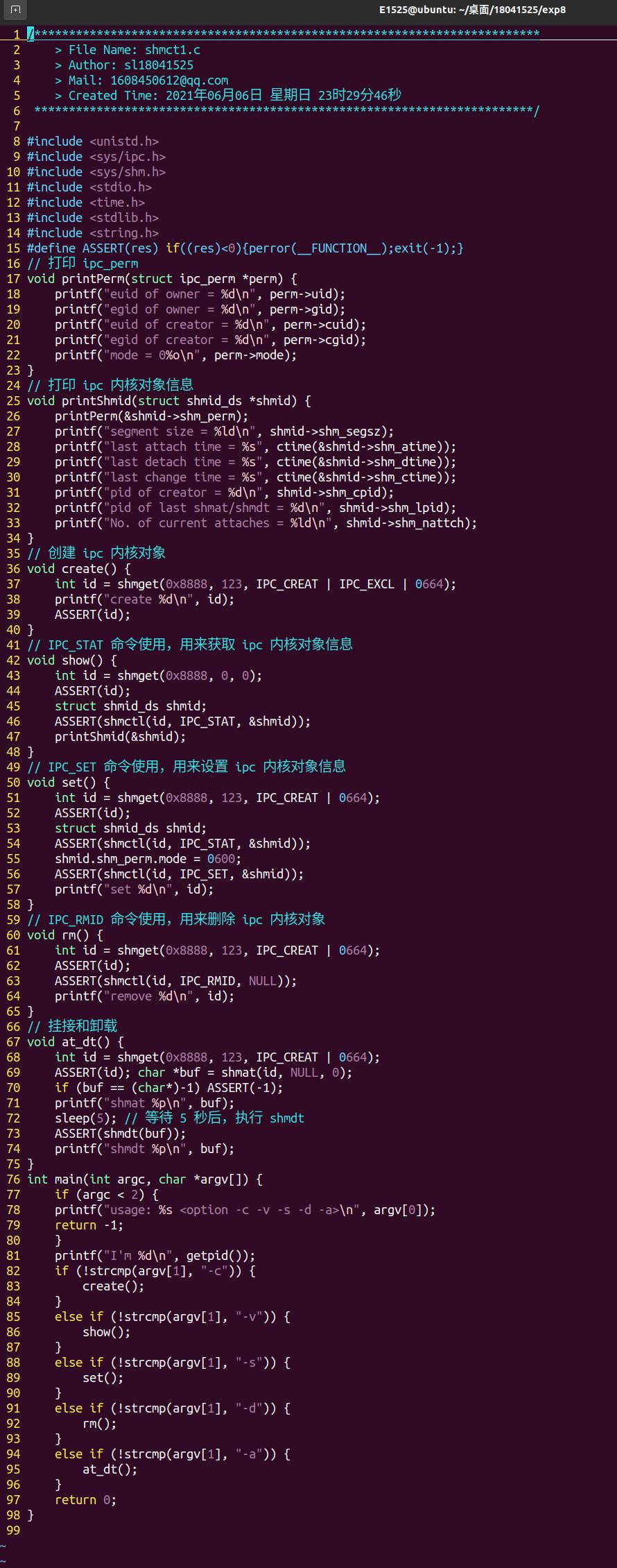
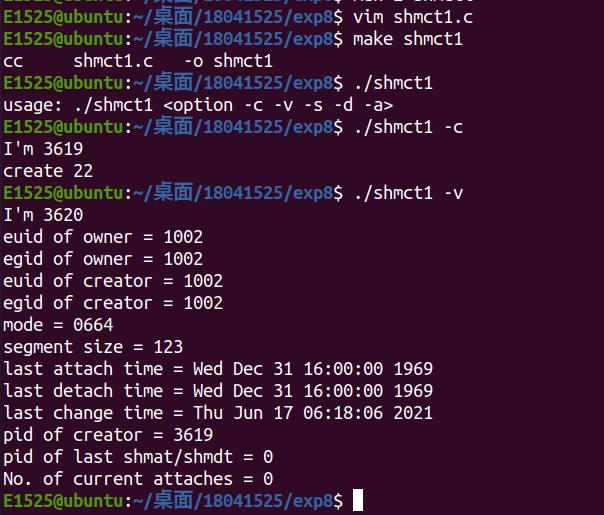
先在另一个终端执行 ./shmctl -a ,然后(5s内)立即在当前终端执行 ./shmctl -v

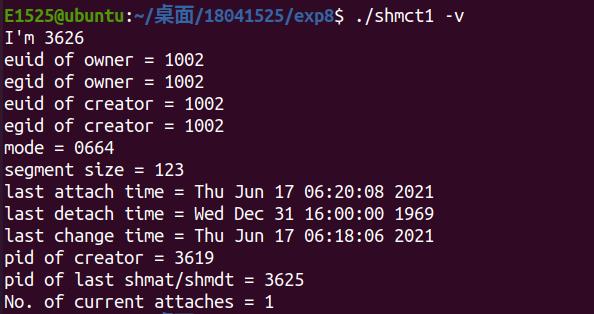
先在另一个终端执行 ./shmctl -a ,运行结束后,然后在当前终端执行 ./shmctl -v

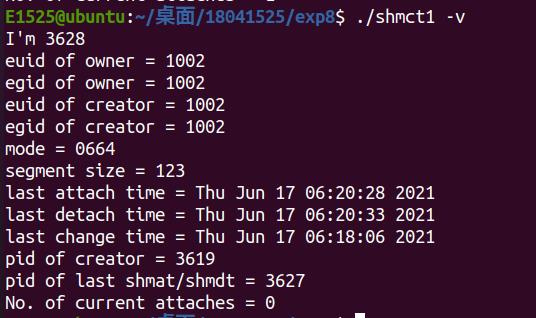
6.编写两程序分别用于向消息队列发送数据和接收数据。 msg_send 程序定义了一个结构体 Msg ,消息正文部分是结构体 Person 。该程序向消息队列发送了 10 条消息。
消息队列
消息队列本质上是位于内核空间的链表,链表的每个节点都是一条消息。
每一条消息都有自己的消息类型,消息类型用整数来表示,
而且必须大于 0.每种类型的消息都被对应的链表所维护,
下图 展示了内核空间的一个消息队列:

其中数字 1 表示类型为 1 的消息,数字2、3、4 类似。彩色块表示消息数据,它们被挂在对应类型的链表上。
值得注意的是,刚刚说过没有消息类型为 0 的消息,
实际上,消息类型为 0 的链表记录了所有消息加入队列的顺序,其中红色箭头表示消息加入的顺序。
消息队列相关的函数
man 2 msgop
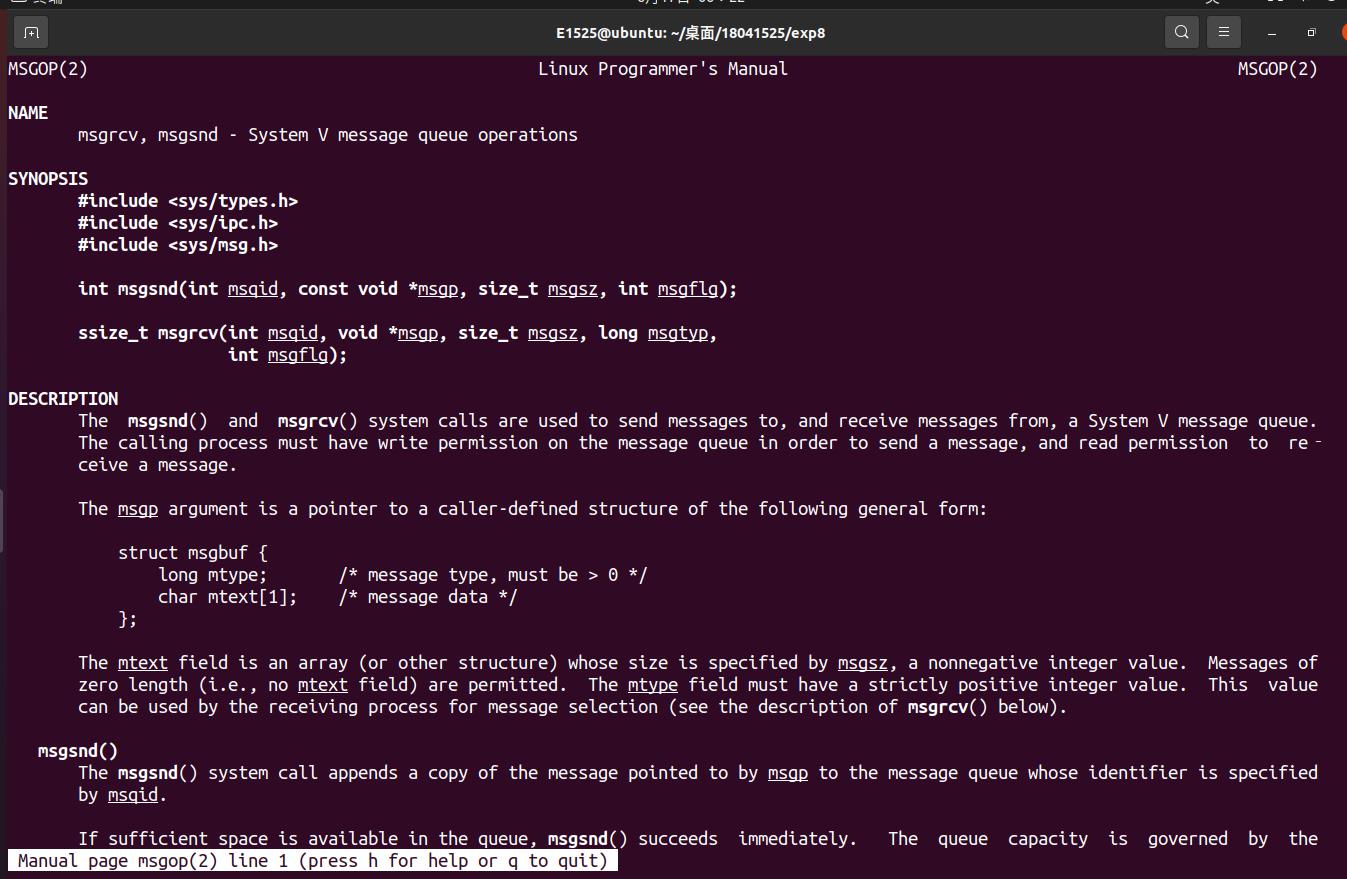
消息数据格式
无论你是发送还是接收消息,消息的格式都必须按照规范来。简单的说,它一般长成下面这个样子
struct Msg{ long type; // 消息类型。这个是必须的,而且值必须 > 0,这个值被系统使用 // 消息正文,多少字节随你而定 // ... }
例题:程序 msg_send 和 msg_recv 分别用于向消息队列发送数据和接收数据。 msg_send 程序定义了一个结构体 Msg ,消息正文部分是结构体 Person 。该程序向消息队列发送了 10 条消息。
// msg_send.c #include <unistd.h> #include <sys/ipc.h>#include <sys/msg.h> #include <stdio.h>#include <stdlib.h>#define ASSERT(prompt,res) if((res)<0){perror(#prompt);exit(-1);} typedef struct { char name[20]; int age; }Person;typedef struct { long type; Person person;}Msg;int main(int argc, char *argv) { int id = msgget(0x8888, IPC_CREAT | 0664); ASSERT(msgget, id); Msg msg[10] = { {1, {"Luffy",17}}, {1, {"Zoro",19}}, {2, {"Nami",18}}, {2, {"Usopo",17}}, {1, {"Sanji",19}}, {3, {"Chopper",15}}, {4, {"Robin",28}}, {4, {"Franky",34}}, {5, {"Brook",88}}, {6, {"Sunny",2}} }; int i; for (i = 0; i < 10; ++i) { int res = msgsnd(id, &msg[i], sizeof(Person), 0); ASSERT(msgsnd, res); } return 0;}
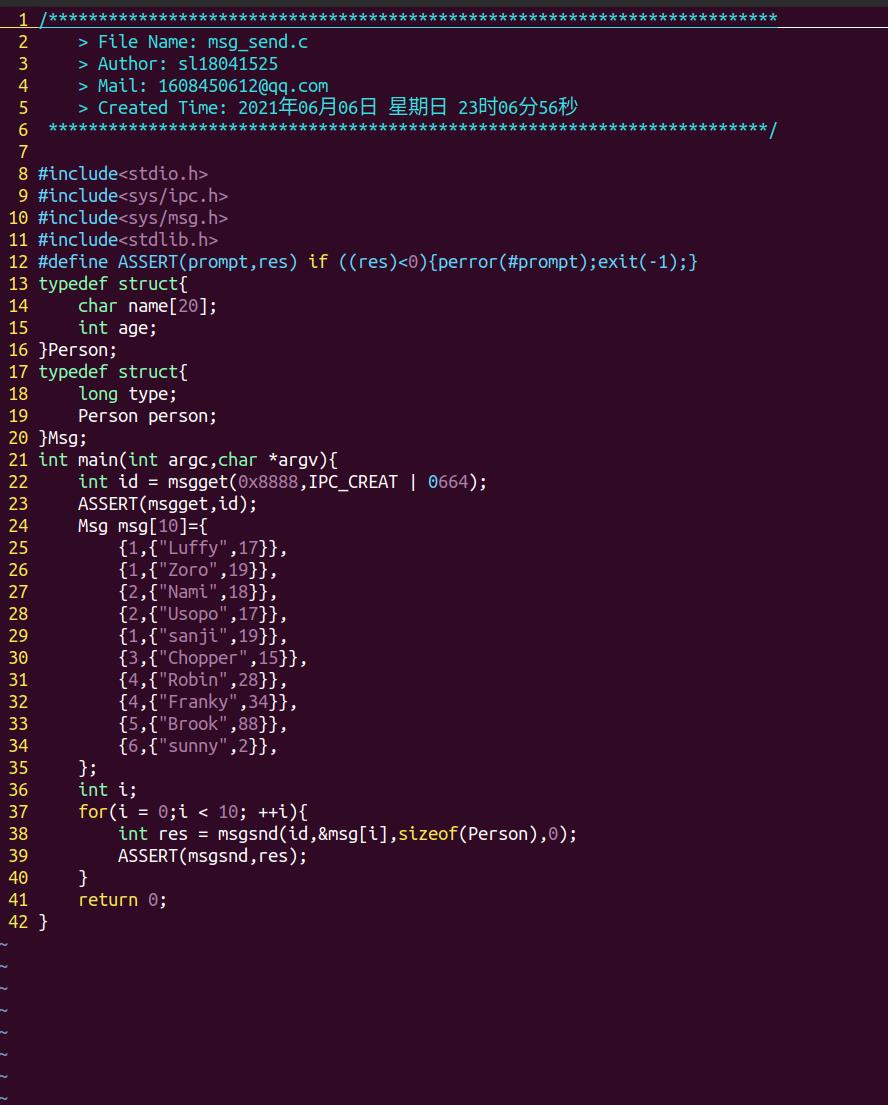
程序 msg_send 第一次运行完后,内核中的消息队列大概像下面这样:

msg_recv 程序接收一个参数,表示接收哪种类型的消息。比如 ./msg_recv 4 表示接收类型为 4 的消息,并打印在屏幕。
// msg_recv.c #include <unistd.h>#include <sys/types.h> #include <sys/ipc.h>#include <sys/msg.h>#include <stdio.h> #include <stdlib.h> #include <errno.h> #define ASSERT(prompt,res) if((res)<0){perror(#prompt);exit(-1);} typedef struct { char name[20]; int age; }Person;typedef struct { long type; Person person;}Msg; void printMsg(Msg *msg) { printf("{ type = %ld, name = %s, age = %d }\\n", msg->type, msg->person.name, msg->person.age); }int main(int argc, char *argv[]) { if (argc < 2) { printf("usage: %s <type>\\n", argv[0]); return -1; } // 要获取的消息类型 long type = atol(argv[1]); // 获取 ipc 内核对象 int id = msgget(0x8888, 0); // 如果错误就退出 ASSERT(msgget, id); Msg msg; int res; while(1) { // 以非阻塞的方式接收类型为 type 的消息 res = msgrcv(id, &msg, sizeof(Person), type, IPC_NOWAIT); if (res < 0) { // 如果消息接收完毕就退出,否则报错并退出 if (errno == ENOMSG) { printf("No message!\\n"); break; } else { ASSERT(msgrcv, res); } } // 打印消息内容 printMsg(&msg); } return 0; }
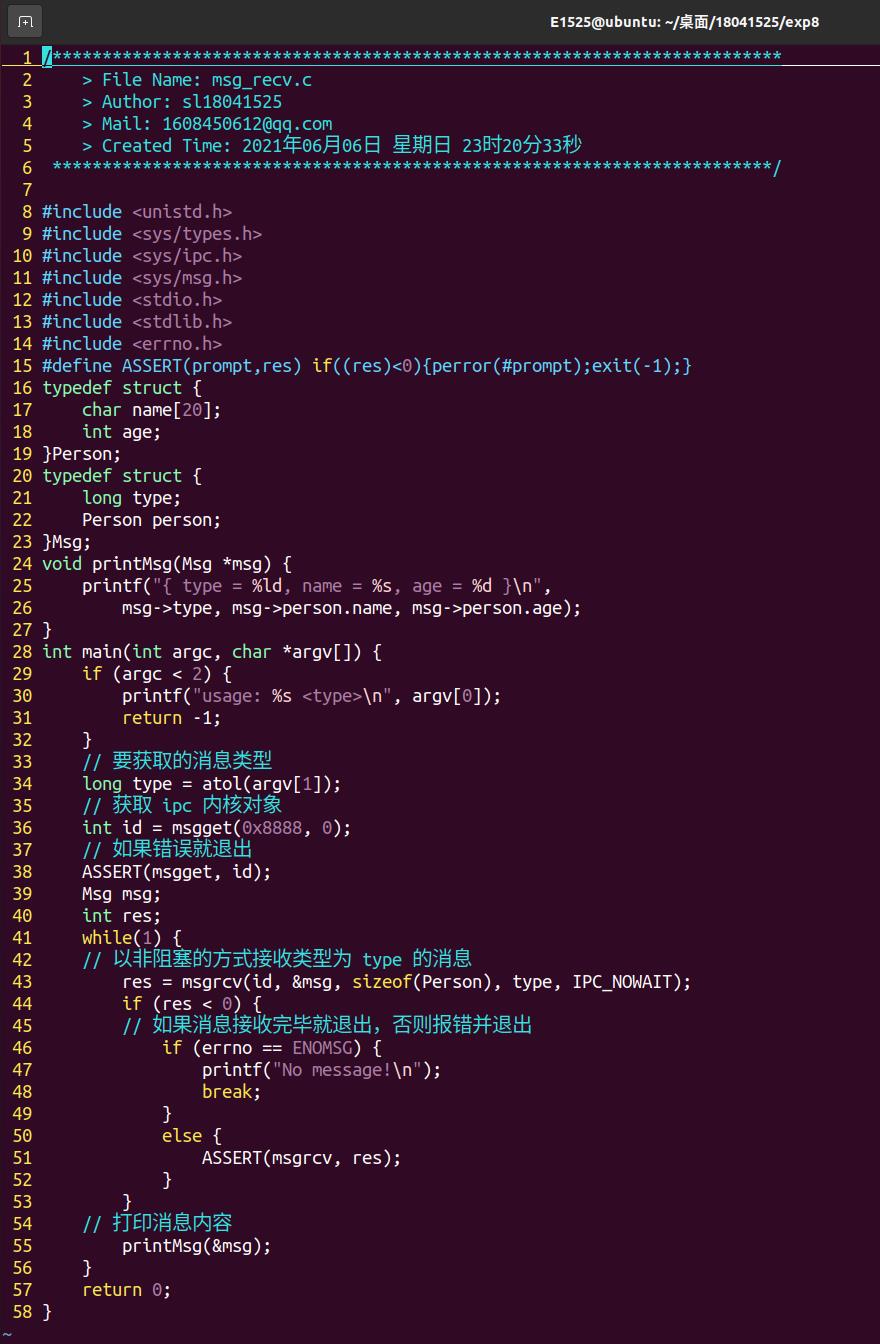
先运行./msg_send,再运行./msg_recv
接收所有消息:
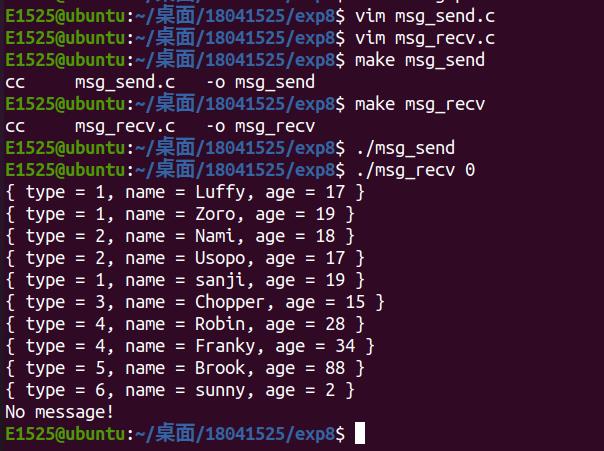
接收类型为 4 的消息,这时要重新运行 ./msg_send :

接收类型小于等于 3 的所有消息,这是不用再运行 ./msg_send :
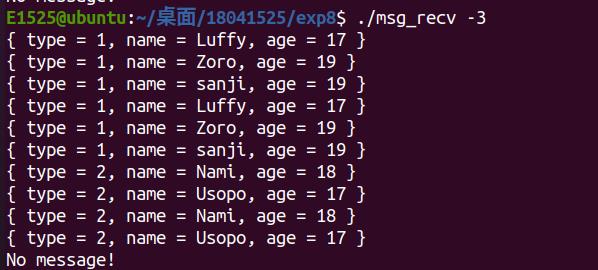
还有一个函数来操作消息队列内核对象的
man 2 msgctl
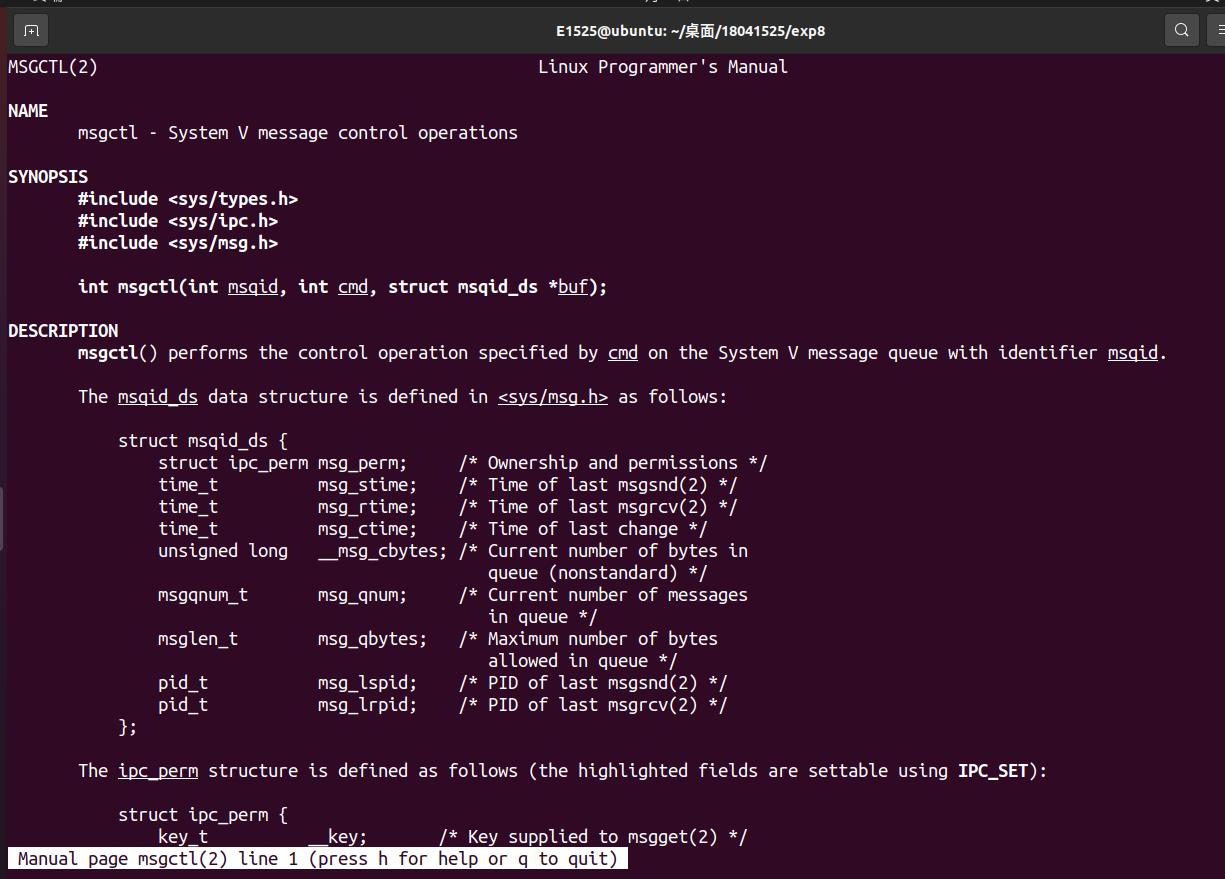
7.编写程序举例说明信号量如何操作。
信号量
设置和获取信号量值的函数 semctl :
man 2 semctl
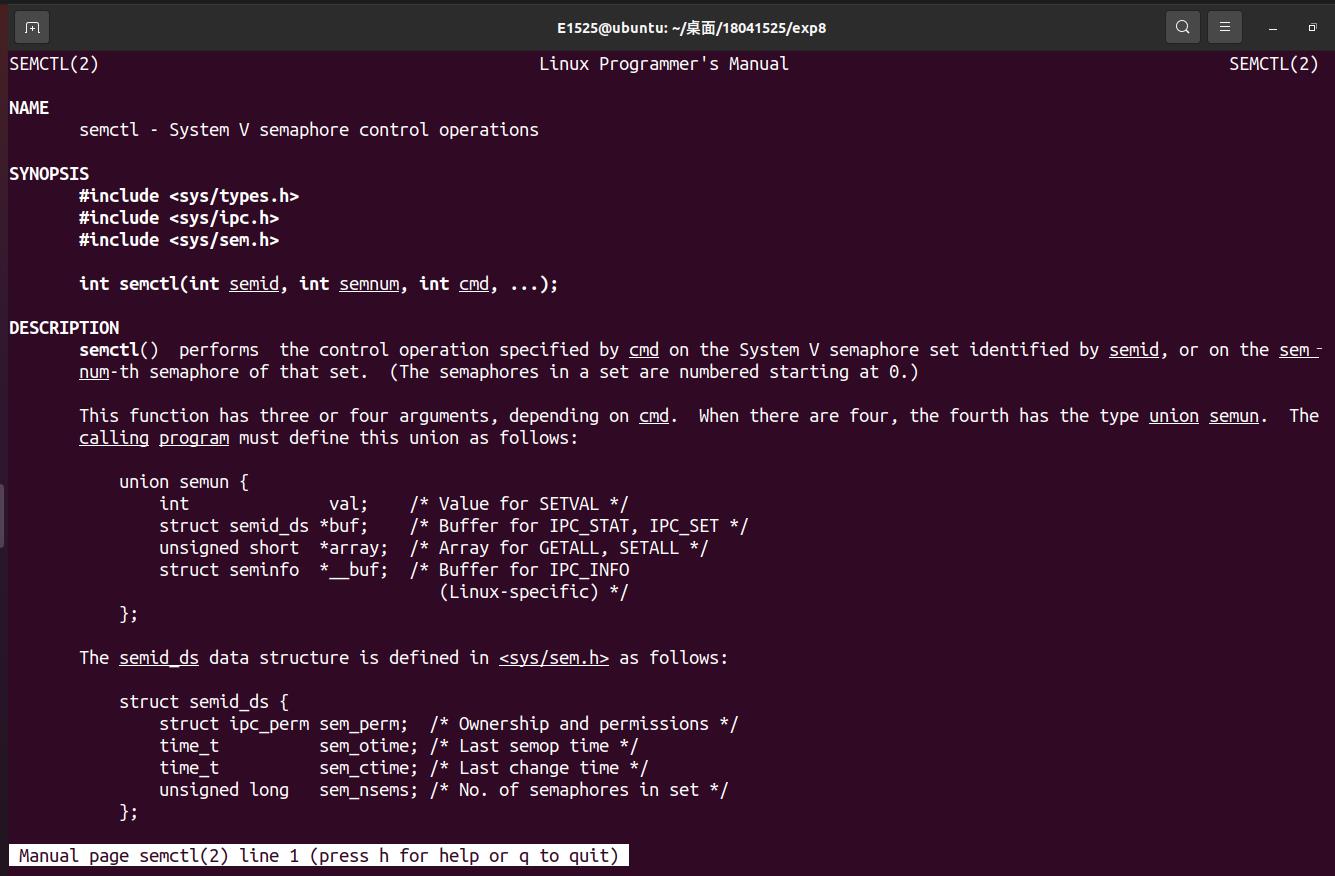
请求和释放信号量 semop
man 2 semop
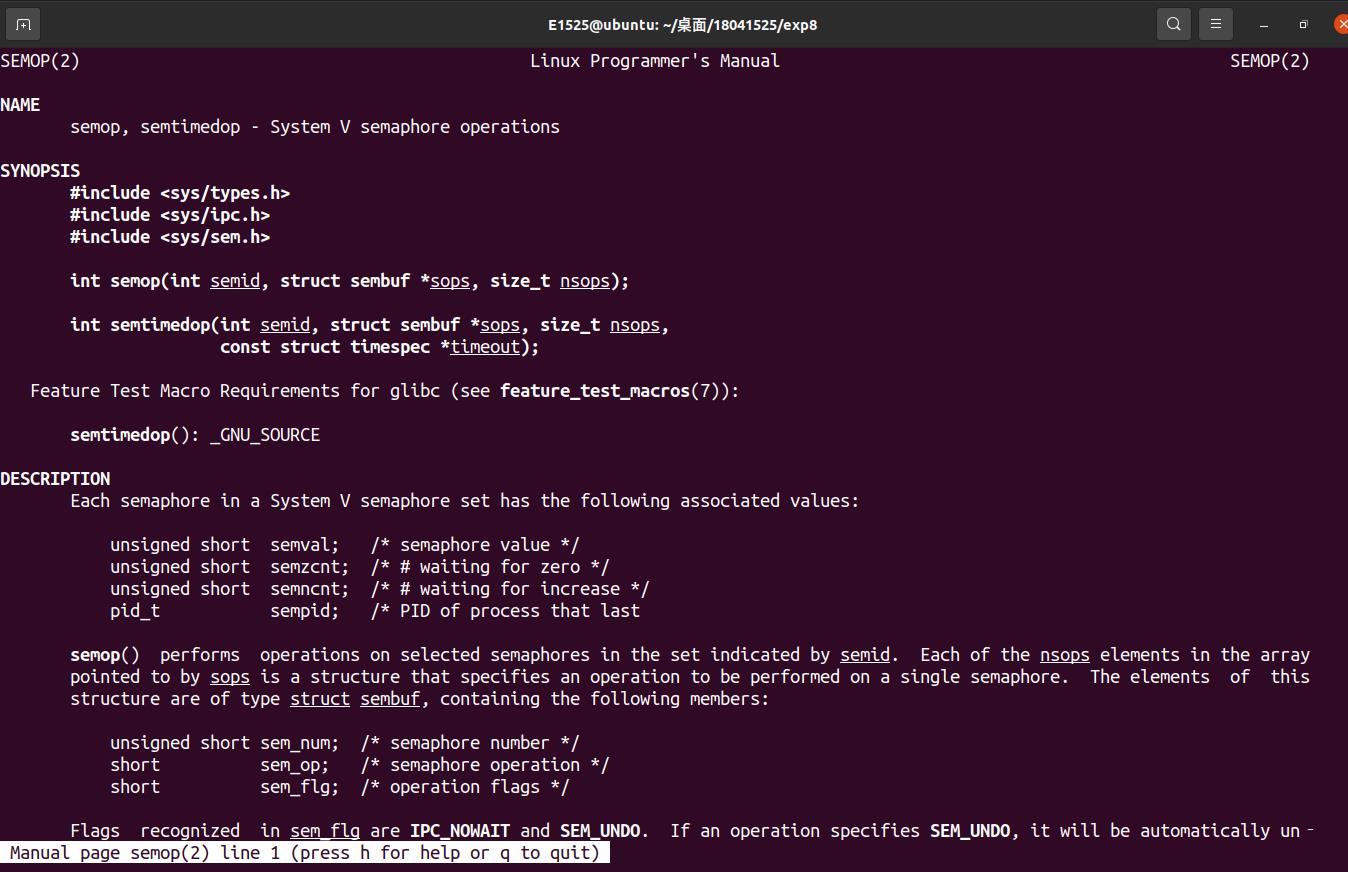
struct sembuf { unsigned short sem_num; /* semaphore number */ short sem_op; /* semaphore operation */ short sem_flg; /* operation flags */}
例题:信号量操作 示例
//semop.c #include <unistd.h> #include <sys/ipc.h> #include <sys/sem.h>#include <stdio.h>#include <stdlib.h> #define R0 0#define R1 1 #define R2 2 void printSem(int id) { unsigned short vals[3] = { 0 }; semctl(id, 3, GETALL, vals); printf("R0 = %d, R1= %d, R2 = %d\\n\\n", vals[0], vals[1], vals[2]); }int main() { int id = semget(0x8888, 3, IPC_CREAT | IPC_EXCL | 0664); // 打印信号量值 puts("信号量初始值(默认值)"); printSem(id); // 1. 设置第 2 个信号量值 puts("1. 设置第 2 个信号量(R2)值为 20"); semctl(id, 2, SETVAL, 20); printSem(id); // 2. 同时设置 3 个信号量的值 puts("2. 同时设置 3 个信号量的值为 12, 5, 9"); unsigned short vals[3] = {12, 5, 9}; semctl(id, 0, SETALL, vals); printSem(id); // 3. 请求 2 个 R0 资源 puts("3. 请求 2 个 R0 资源"); struct sembuf op1 = {0, -2, 0}; semop(id, &op1, 1); printSem(id); // 4. 请求 3 个 R1 和 5 个 R2 puts("4. 请求 3 个 R1 和 5 个 R2"); struct sembuf ops1[2] = { {1, -3, 0}, {2, -5, 0} }; semop(id, ops1, 2); printSem(id); // 5. 释放 2 个 R1 puts("5. 释放 2 个 R1"); struct sembuf op2 = {1, 2, 0}; semop(id, &op2, 1); printSem(id); // 6. 释放 1 个 R0, 1 个 R1,3 个 R2 puts("6. 释放 1 个 R0, 1 个 R1,3 个 R2"); struct sembuf ops2[3] = { {0, 1, 0}, {1, 1, 0}, {2, 3, 0} }; semop(id, ops2, 3); printSem(id); // 7. 删除 ipc 内核对象 puts("7. 删除 ipc 内核对象"); semctl(id, 0, IPC_RMID); return 0; }
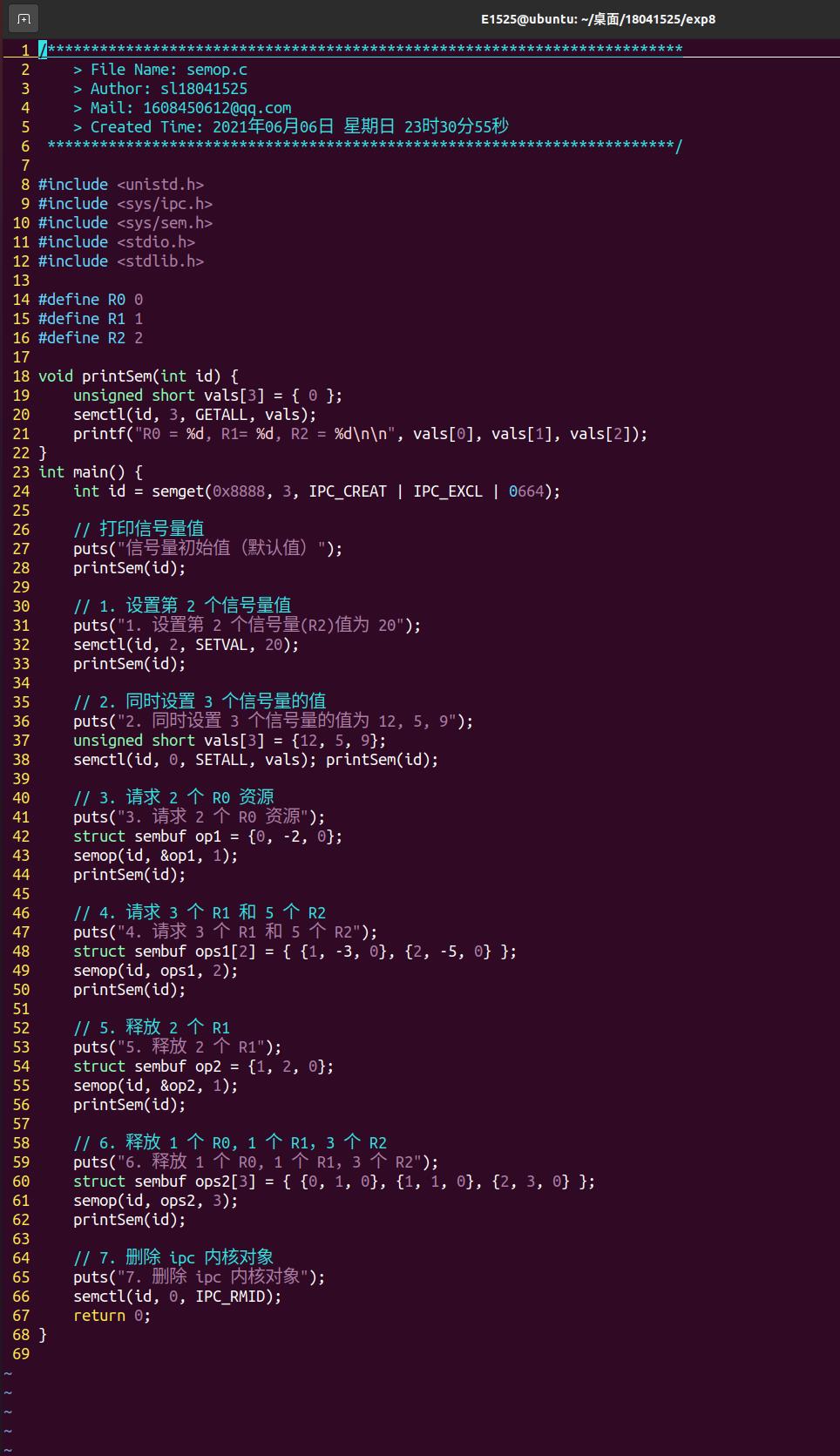
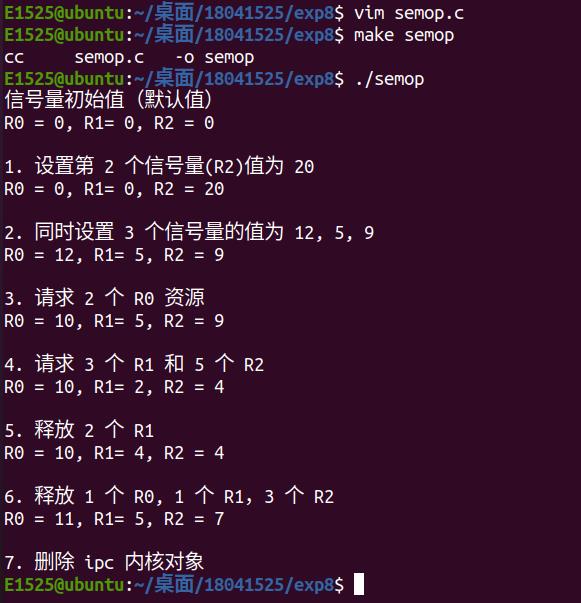
8.编写程序使用信号量实现父子进程之间的同步,防止父子进程抢夺 CPU。
例题:使用信号量实现父子进程之间的同步,防止父子进程抢夺 CPU 。
#include<stdio.h> #include<stdlib.h>#include<sys/ipc.h>#include<sys/sem.h> static int semid; static void sem_set(){ if(semctl(semid,0,SETVAL,1)==-1) { perror("semctl"); exit(1); } }static void sem_p(){ struct sembuf op = {0,-1,0}; if(semop(semid,&op,1) == -1){ perror("semop"); exit(1); } }static void sem_v(){ struct sembuf op = {0,1,0}; if(semop(semid,&op,1) == -1){ perror("semop"); exit(1); }}static void sem_del(){ if(semctl(semid,0,IPC_RMID) == -1){ perror("semctl"); exit(1); }}int main(){ int i; pid_t pid; char ch = \'C\'; semid = semget((key_t)1000,1,0664|IPC_CREAT); if(semid == -1){ perror("semget"); exit(1); } sem_set(); pid = fork(); if(pid == -1){ sem_del(); exit(1); } else if (pid == 0) ch = \'Z\'; else ch = \'C\'; srand((unsigned int)getpid()); for(i=0;i<8;i++) { sem_p();// printf("%c",ch); fflush(stdout); sleep(rand()%4); printf("%c",ch); fflush(stdout); sleep(1); sem_v();// } if(pid > 0) { wait(NULL); sem_del(); } printf("\\n"); return 0;}

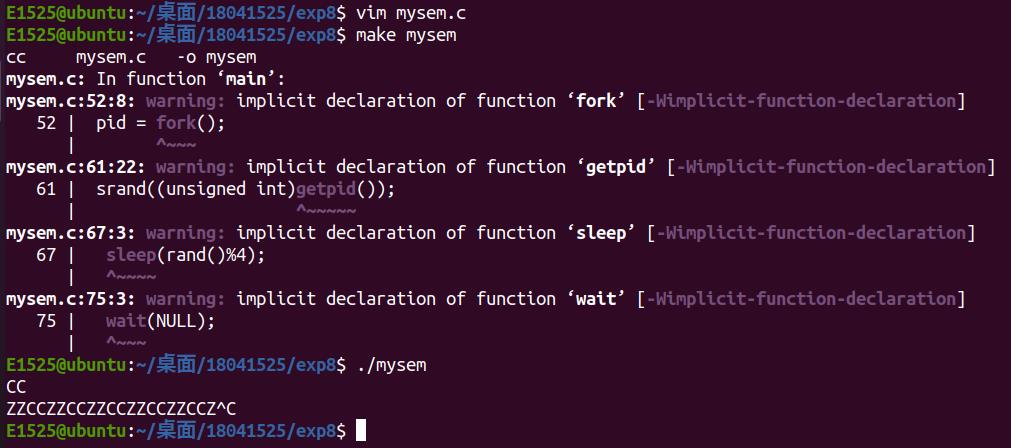
这里可以看到字符是成对出现的,如果修改程序把63行 sem_p(); 和70行 sem_v();
注释掉,在编译运行会发现字符可能就不会成对出现了,这里就是用信号量来帮我们实现进程间的同步的。
以上是关于实验八 进程间通信的主要内容,如果未能解决你的问题,请参考以下文章